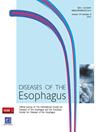385.在食道癌临床前模型中转化分子靶向荧光探针
IF 2.3
3区 医学
Q3 GASTROENTEROLOGY & HEPATOLOGY
引用次数: 0
摘要
背景术中分子成像(IMI)是一个新兴领域,它利用肿瘤靶向荧光探针来改善肿瘤治疗效果。一种新型探针被称为 "基于淬灭活性的探针(qABP)",用于测量体外酶的活性。与其他肿瘤靶向探针不同的是,在 qABP 与 cathepsins 共价键合之前,荧光一直受到抑制,直到释放出抑制性淬灭剂,从而产生荧光。这可以提高正常组织与肿瘤之间的对比度。我们的实验小组试图获得临床前证据,以便最终将 qABP 应用于食道癌、交界性癌症和胃癌的手术室。我们用两种名为 BMV109 和 VGT309 的 qABP 对正常食道、巴雷特变性、食道腺癌 (OAC)、鳞状细胞癌 (SCC) 和胃腺癌 (GAC) 的细胞系进行了嗜酪蛋白酶活性筛选。我们还筛查了食道癌、交界性癌和胃癌患者的活检样本。我们使用凝胶内荧光(Amersham Typhoon®)和 Western 印迹对细胞系和组织样本进行了分析。在体内,使用皮下和正位模型在 NSG 小鼠体内建立细胞系异种移植。然后向肿瘤小鼠注射 VGT-309,并使用 IVIS® 光谱成像仪在特定时间点进行成像。结果 在所有食道-胃细胞系中都发现了钙蛋白酶活性,并用钙蛋白酶抑制剂证明了其选择性。在新辅助化疗和放疗前后收集了患者的匹配活检样本。基线肿瘤活检组织显示出明显高于正常活检组织的钙蛋白酶活性,这些差异在化疗放疗后收集的活检组织中得以保留(p&p;lt;0.001)。在体内,早在注射 VGT-309 12 小时后,就能在 NSG 小鼠体内发现 OAC 和 GAC 异种移植物,其荧光比正常背景胃增加了 2.5 倍。生物分布分析表明,VGT-309 在肝脏和肾脏中积累,但在小鼠食道和胃中积累较少。结论 将 qABP 移植到手术室有可能检测出巴雷特化生期的早期癌症,降低阳性边缘率并识别淋巴结转移。我们的研究小组将继续研究 qABP,包括确定其检测淋巴结转移的灵敏度,以便将这项技术转化为一期临床试验。本文章由计算机程序翻译,如有差异,请以英文原文为准。
385. TRANSLATING MOLECULAR-TARGETING FLUORESCENT PROBES IN OESOPHAGEAL CANCER PRE-CLINICAL MODELS
Background Intra-operative molecular imaging (IMI) is an emerging field that utilises tumour-targeting fluorescent probes to improve oncological outcomes. A novel class of probe known as quenched activity-based probes (qABP), developed to measure enzyme activity in-vitro, has been repurposed to target tumour-expressed proteases known as cathepsins. Unlike other tumour-targeting probes, fluorescence is inhibited up until the qABP covalently bonds to cathepsins, releasing an inhibitory quencher which results in fluorescence. This may improve the contrast between normal tissue and tumour. Our laboratory group sought to obtain pre-clinical evidence to eventually translate qABP’s into the operating room for oesophageal, junctional and gastric cancer. Methods Cathepsin activity was screened in cell lines from the normal oesophagus, Barrett’s metaplasia, oesophageal adenocarcinoma (OAC), squamous cell carcinoma (SCC) and gastric adenocarcinoma (GAC) with two qABP’s known as BMV109 and VGT309. We additionally screened patient biopsies from oesophageal, junctional and gastric cancers. Cell line and tissue samples were analysed using in-gel fluorescence (Amersham Typhoon®) and Western blot. In-vivo, cell line xenografts were established in NSG mice using subcutaneous and orthotopic models. Tumour-bearing mice were then injected with VGT-309 and then imaged at specific timepoints using the IVIS® spectrum imager. Results Cathepsin activity was found in all oesophago-gastric cell lines and selectivity proven with a cathepsin inhibitor. Matched biopsies were collected from patients prior before and after neoadjuvant chemo-radiotherapy. Baseline tumour biopsies exhibited significantly higher cathepsin activity than normal biopsies, with these differences preserved in biopsies collected after chemo-radiotherapy (p <0.001). In-vivo, OAC and GAC xenografts were identified in NSG mice as early as 12 hours post injection of VGT-309, exhibiting a 2.5-fold increase in fluorescence compared to normal background stomach. Bio-distribution analysis demonstrated that VGT-309 accumulated in liver and kidney, but less so in the murine oesophagus and stomach. Conclusion Translating qABP’s into the operating room has the potential to detect early cancers in Barrett’s metaplasia, reduce positive margin rates and identify lymph node metastasis. Our research group continues to investigate qABP’s, including determining their sensitivity to detect lymph node metastasis with the aim of translating this technology into a phase 1 clinical trial.
求助全文
通过发布文献求助,成功后即可免费获取论文全文。
去求助
来源期刊

Diseases of the Esophagus
医学-胃肠肝病学
CiteScore
5.30
自引率
7.70%
发文量
568
审稿时长
6 months
期刊介绍:
Diseases of the Esophagus covers all aspects of the esophagus - etiology, investigation and diagnosis, and both medical and surgical treatment.
 求助内容:
求助内容: 应助结果提醒方式:
应助结果提醒方式:


